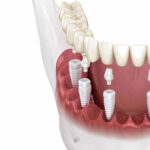Gum recession in Bloomfield Hills, MI can seem like it happens overnight because many people do not notice it until the signs and symptoms are evident. Gum recession happens gradually, though. It should not be ignored during any of its stages, including when it first starts. Why? A well-trained periodontist can help a patient reverse gum recession in Bloomfield Hills, MI!
To recognize gum recession, patients should learn what it is, what causes it, and how an advanced periodontist can treat the condition.
What Is Gum Recession And Why Does It Happen?
The gums play an important role in peoples’ mouths. They protect the teeth and bone by creating a special barrier. Without gums, the whole tooth, including the root, would be exposed to moisture, bacteria, and air. So would the bone in the jaw, as well as some oral nerves.
Gum recession in occurs when the gums start to pull back from their protective position. Some causes of gum recession include:
Heredity:
Genetics sometimes can be a reason for gum recession. If a patients’ mother, father, or siblings have or had gum recession, they may be a candidate for it as well. In the field of periodontics, this can be referred to as “thin bone” or “thin gum.”
Improper Oral Care At Home:
Aggressive flossing and brushing can wear down the gums.
Orthodontic Issues:
Teeth can move or erupt outside the bony house where they belong, causing soft tissue to settle or stretch where it does not belong.
Gum Disease:
Untreated gum disease destroys healthy gum tissue. As the tissue becomes more diseased, the gums begin to recede.
What Does Gum Recession Look And Feel Like?
When a patient has gum recession, they will usually have several indications that their gums are not in proper placement.
Long Teeth:
Teeth seem to look longer over time. As the gums recede, the teeth begin to take on length.
Tooth Sensitivity:
Teeth have become more sensitive to hot, cold, and even sweets. For example, when drinking
hot coffee, teeth may hurt.
Bleeding Gums:
Gums may bleed or swell, particularly after brushing or flossing.
Uneven Smile:
Patients may feel that their smile looks uneven in pictures.
Each of these signs could point to one or a combination of many factors causing gum recession, including some unique to a patients’ situation and history. Getting a diagnosis from a trusted periodontist will help in finding out why a patient’s gums seem to be pulling back from their teeth.
At our office, Dr. Lauren Anderson will examine your gums visually and with the assistance of 3D scanning equipment. This allows her to recommend solutions such as soft tissue grafting.
Tell Me More About Soft Tissue Graft Processes!
There are a few types of soft tissue grafts that can solve gum recession. When working with Dr. Anderson, she will suggest the one that is least invasive and best suited for every individual case. She will discuss the procedure from beginning to end and explain why she feels it will be advantageous for her patient.
Excellent care of the gums does not end with a gum graft, though. After undergoing gum grafting, dental patients often continue to visit Dr. Anderson, ensuring that both the patient and doctor are happy with the long-term results.
Treatment Options For Gum Recession
When it comes to treatment options for gum recession, patients have many choices. This is great news because it allows the patient to get individualized care instead of a one-size-fits-all solution. Below are five of the most dependable forms of treatment for gum recession in Bloomfield Hills, MI.
At the first appointment with Dr. Anderson, she may recommend one or several depending upon the state of the patients gums and her expertise in helping people overcome their gum recession effectively.
Tunneling Allograft Technique
During a tunneling allograft procedure, Dr. Anderson will carefully and selectively insert grafting material into small “tunnels” made in the gum tissues. The tunnels are made with tiny instruments that precisely create just enough room under existing gums to accommodate the graft.
Before and after images of tunneling allograft patients show how remarkable the results of this gum recession treatment technique can be. If a patient has many areas of receding gums, a tunneling allograft may be the right option because it can be performed in multiple places during one appointment.
Coronally Advanced Flap Technique
What if a patient has a healthy amount of gum tissue near the site of their gum recession? In this situation, the coronally advanced flap technique could be right for their needs. This procedure involves gently loosening the gum tissue so it can be moved gently to cover any exposed areas.
Sometimes, Dr. Anderson will suggest adding grafting material from a patients’ body or another source—called an allograft—to improve their outcomes. Either way, patients can enjoy a much healthier smile and protected teeth and bone.
Semilunar Technique
Just because patients have gum recession around some teeth does not mean their gums are thin or receding everywhere. What happens if a patient has an abundant amount of gum tissue surrounding their gum recession? This is when a semilunar technique might be the right gum recession treatment.
The semilunar technique is a little like the coronally advanced flap technique because it makes use of existing gum tissues. However, in the semilunar technique, a flap of a patient’s abundant gums is carefully moved to cover the areas where they are missing gum tissues. After it is sutured into place, the flap will heal and become part of the patient’s natural gum line.
Free Gingival Graft Procedure
A free gingival graft procedure makes excellent use of high-tech grafting to address thinning gums. In other words, patients do not need to have excess gum tissues to correct their gum recession in Bloomfield Hills, MI!
With the free gingival graft, material will be taken from the roof of a patients mouth. The material will be sutured in place and allowed to heal over many weeks. Free gingival grafts allow patients to restore the integrity of their gums.
Lateral Pedicle Flap Procedure
The final type of gum recession treatment that may work for some patients is a lateral pedicle flap procedure. As with some of the other types of receding gum solutions, the lateral pedicle flap involves borrowing nearby healthy, abundant gum tissue.
During this procedure, gum tissue is shifted from either side of the site of the gum recession to cover any exposed teeth, tooth roots, or jawbone. Reattachment of the maneuvered gum tissue happens fairly quickly, and the patient can count on seeing a difference very soon after undergoing this popular and safe gum recession treatment.
World-Class Gum Recession Treatment In Bloomfield Hills, MI
Dr. Anderson has dedicated her career to learning innovative periodontal procedures to help her patients. She has published numerous academic papers and given lectures in her field. She also has received countless awards, including the Michigan Dental Association Young Dentist Award.
Instead of ignoring or living with your gum recession, you owe it to your health to get an educated opinion on ways to treat it. Get in contact with Dr. Anderson at our advanced Anderson Periodontal Wellness office to schedule an appointment with us today! You can put an end to your gum recession and open the door to a beautiful new beginning for your smile.





